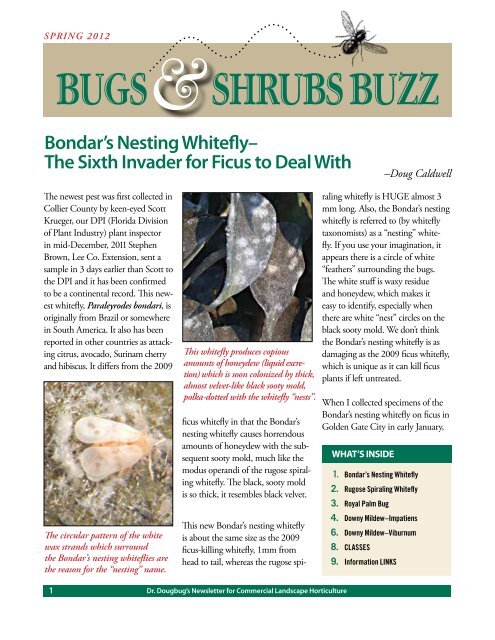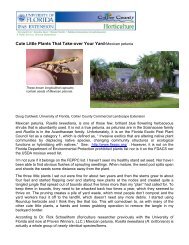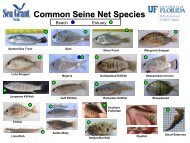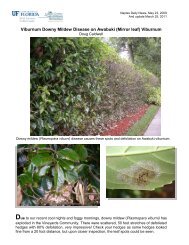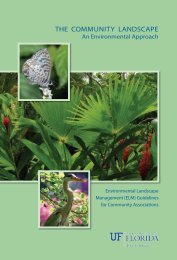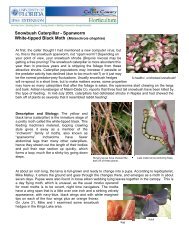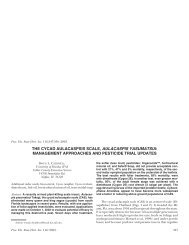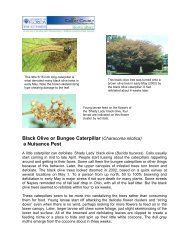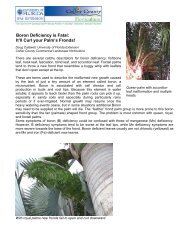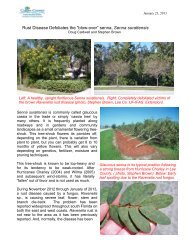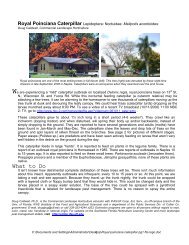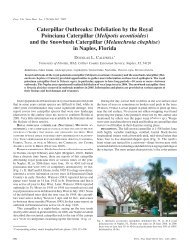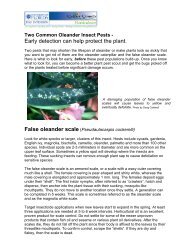bugs shrubs buzz - Collier County Extension Office - University of ...
bugs shrubs buzz - Collier County Extension Office - University of ...
bugs shrubs buzz - Collier County Extension Office - University of ...
You also want an ePaper? Increase the reach of your titles
YUMPU automatically turns print PDFs into web optimized ePapers that Google loves.
SPRING 2012<br />
EDITION TWO • MAY 2012<br />
Bondar’s Nesting Whitefly–<br />
The Sixth Invader for Ficus to Deal With<br />
1<br />
BUGS SHRUBS BUZZ<br />
The newest pest was first collected in<br />
<strong>Collier</strong> <strong>County</strong> by keen-eyed Scott<br />
Krueger, our DPI (Florida Division<br />
<strong>of</strong> Plant Industry) plant inspector<br />
in mid-December, 2011 Stephen<br />
Brown, Lee Co. <strong>Extension</strong>, sent a<br />
sample in 3 days earlier than Scott to<br />
the DPI and it has been confirmed<br />
to be a continental record. This newest<br />
whitefly, Paraleyrodes bondari, is<br />
originally from Brazil or somewhere<br />
in South America. It also has been<br />
reported in other countries as attacking<br />
citrus, avocado, Surinam cherry<br />
and hibiscus. It differs from the 2009<br />
The circular pattern <strong>of</strong> the white<br />
wax strands which surround<br />
the Bondar’s nesting whiteflies are<br />
the reason for the “nesting” name.<br />
This whitefly produces copious<br />
amounts <strong>of</strong> honeydew (liquid excre-<br />
tion) which is soon colonized by thick,<br />
almost velvet-like black sooty mold,<br />
polka-dotted with the whitefly “nests”.<br />
ficus whitefly in that the Bondar’s<br />
nesting whitefly causes horrendous<br />
amounts <strong>of</strong> honeydew with the subsequent<br />
sooty mold, much like the<br />
modus operandi <strong>of</strong> the rugose spiraling<br />
whitefly. The black, sooty mold<br />
is so thick, it resembles black velvet.<br />
This new Bondar’s nesting whitefly<br />
is about the same size as the 2009<br />
ficus-killing whitefly, 1mm from<br />
head to tail, whereas the rugose spi-<br />
Dr. Dougbug’s Newsletter for Commercial Landscape Horticulture<br />
–Doug Caldwell<br />
raling whitefly is HUGE almost 3<br />
mm long. Also, the Bondar’s nesting<br />
whitefly is referred to (by whitefly<br />
taxonomists) as a “nesting” whitefly.<br />
If you use your imagination, it<br />
appears there is a circle <strong>of</strong> white<br />
“feathers” surrounding the <strong>bugs</strong>.<br />
The white stuff is waxy residue<br />
and honeydew, which makes it<br />
easy to identify, especially when<br />
there are white “nest” circles on the<br />
black sooty mold. We don’t think<br />
the Bondar’s nesting whitefly is as<br />
damaging as the 2009 ficus whitefly,<br />
which is unique as it can kill ficus<br />
plants if left untreated.<br />
When I collected specimens <strong>of</strong> the<br />
Bondar’s nesting whitefly on ficus in<br />
Golden Gate City in early January,<br />
WHAT’S INSIDE<br />
1. Bondar’s Nesting Whitefly<br />
2. Rugose Spiraling Whitefly<br />
3. Royal Palm Bug<br />
4. Downy Mildew–Impatiens<br />
6. Downy Mildew–Viburnum<br />
8. CLASSES<br />
9. Information LINKS
EDITION TWO • MAY 2012<br />
2012, there were eggs and adults. It<br />
appears this species may be active in<br />
the winter while the 2009 ficuskilling<br />
whitefly is not as active.<br />
This could be a serious double-barreled<br />
whammy for ficus. Stay tuned<br />
in with us at: collier.ifas.ufl.edu<br />
Five Ficus Pests–History<br />
Ficus was once a bullet pro<strong>of</strong> plant,<br />
the “King <strong>of</strong> Hedgery” with no significant<br />
pests. However, surprise, we<br />
have had wave after wave <strong>of</strong> attack<br />
in <strong>Collier</strong> <strong>County</strong>!<br />
[1] In 2003, lobate lac scale<br />
(Paratachardina pseudolobata)<br />
arrived. It is the only other insect<br />
which will result in copious<br />
amounts <strong>of</strong> sooty mold on weeping<br />
ficus, (Ficus benjamina).<br />
[2] In 2007, Cuban-laurel<br />
hedges were infested with the blister<br />
(banyan) leaf gall wasp (Josephiella<br />
microcarpae). This was the first time<br />
it was found in the state.<br />
[3] In early 2008 or so, weeping<br />
ficus thrips (Gynaikothrips uzeli),<br />
became common on weeping ficus<br />
hedges.<br />
[4] In January 2008 the eye-spot<br />
midge (Horidiplosis ficifolii) was<br />
found peppering Ficus benjamina<br />
and causing some leaf drop.<br />
[5] Then the ficus-killing<br />
whitefly (Singhiella simplex) arrived<br />
in January 2009. This onslaught <strong>of</strong><br />
new pests really must be some sort<br />
<strong>of</strong> historical record.<br />
2<br />
What to Do<br />
Since these are all sucking insects,<br />
if one is using a root drench or<br />
trunk spray <strong>of</strong> the systemic neonic<br />
insecticides (refer to web links on<br />
page 3 for specific treatments), you<br />
should control all <strong>of</strong> these pests.<br />
More on Rugose Spiraling<br />
Whitefly (RSW)<br />
Here’s an update on the rugose<br />
spiraling whitefly (Aleurodicus<br />
rugioperculatus) alert which I first<br />
talked about in July 2011. I was<br />
shocked in mid April as I drove<br />
south on 3rd St. and the general<br />
area to see so many coconut palms<br />
dripping with honeydew and sooty<br />
mold; some were almost black. I also<br />
found this pest on royal and foxtail<br />
palms which have not been reported<br />
as hosts. Cabbage palms remain<br />
whitefly free at this point in time.<br />
The RSW has a confirmed host<br />
list <strong>of</strong> 90 plants and growing– including:<br />
gumbo limbo, bucida<br />
(black olive), copperleaf, Norfolk<br />
Island pine, periwinkle, cocoplum,<br />
buttonwood, mango, live oak,<br />
Dr. Dougbug’s Newsletter for Commercial Landscape Horticulture<br />
coconut, areca, Christmas and<br />
supposedly cabbage palms.<br />
What to Do<br />
Fortunately, this whitefly isn’t as<br />
damaging as the ficus whitefly. The<br />
major issue is the mess it makes.<br />
Especially when one keeps a boat<br />
under the coconut palms along the<br />
dock. Also, swimming pool filters<br />
have gotten clogged with the waxy<br />
mess and the pests. This is another<br />
first! The pool maintenance guys<br />
are having trouble keeping the pool<br />
algae under control. The drippy<br />
honeydew is rich in nitrogen or<br />
phosphorous creating extra service<br />
calls. I’ve heard <strong>of</strong> some people<br />
cutting their coconut palms down!<br />
Good grief, please have some<br />
perseverance! Some good <strong>bugs</strong><br />
have been found attacking it, a<br />
parasitic wasp and lady beetles. So<br />
avoid spraying with long residual<br />
pesticides as the good attack <strong>bugs</strong><br />
may end up as collateral damage.<br />
Besides root-soil injections <strong>of</strong><br />
systemics, trunk injections are<br />
looking promising too, especially<br />
when plants are near water where<br />
spraying could cause drift issues.<br />
<br />
Look for the white waxy egg spirals <strong>of</strong> the rugose spiraling whitefly.
EDITION TWO • MAY 2012<br />
Royal palm <strong>bugs</strong> (Xylastodoris<br />
luteolus) are like chinch <strong>bugs</strong> on turf<br />
grass! With their sucking mouthparts<br />
they cause the newest fronds<br />
to have brown areas in April-May.<br />
Although they are not thought <strong>of</strong><br />
as a serious threat, they certainly<br />
can cause considerable aesthetic<br />
damage by their feeding activity.<br />
I’ve had several calls from Marco<br />
Island to Gulf Shore Blvd. and<br />
seen the damage in Port Royal and<br />
3<br />
MORE INFORMATION ON<br />
Whitefly<br />
Rugose Spiraling Whitefly<br />
By Dr. Catharine Mannion<br />
http://tinyurl.com/7x6wbhr<br />
2009 Ficus Whitefly Management<br />
in the Landscape By Dr.<br />
Catharine Mannion<br />
http://tinyurl.com/85m6vvd<br />
Bugs & Shrubs Newsletter 2008<br />
http://tinyurl.com/72exgpo<br />
New Pest Alert Fall 2011<br />
http://tinyurl.com/3qnc2dz<br />
DPI Bondar’s Whitefly<br />
http://tinyurl.com/7qwzout<br />
Palms Under Attack<br />
by Royal Palm Bugs<br />
–Doug Caldwell<br />
PHOTO CREDIT: Lyle Buss, UF<br />
Royal palm <strong>bugs</strong> are almost as<br />
flat as a piece <strong>of</strong> paper and feed<br />
between the closed leaflets <strong>of</strong> newly<br />
emerging fronds.<br />
other areas. Feeding by adults and<br />
nymphs occurs in the spear leaf and<br />
newly expanding fronds. As the<br />
fronds unfurl, the damaged leaflets<br />
are tan-gray, stunted and eventually<br />
become ragged. Damage is heaviest<br />
from mid-March to early July. Damage<br />
by the insects is minimal once<br />
the rainy season starts. Diagnosing<br />
can be tricky. Early damage on<br />
the newest fronds can be confused<br />
with manganese deficiency. Later<br />
in the season as the youngest attacked<br />
fronds droop as they become<br />
the older, lower fronds within the<br />
canopy, the damage resembles<br />
potassium deficiency. This insect<br />
isn’t an “every year bug”, it seems to<br />
have peaks every 15 to 20 years.<br />
What To Do<br />
Merit (imidacloprid) and related<br />
Dr. Dougbug’s Newsletter for Commercial Landscape Horticulture<br />
products (neonicotinoid systemic<br />
insecticides) used as a root drench<br />
have proven effective. For immediate<br />
results crown drenches, usually<br />
applied with an extended low pressure<br />
pole nozzle or from a hydraulic<br />
lift to avoid drift, which would be<br />
unavoidable if they were sprayed<br />
from the ground, may be necessary.<br />
Soil applications should give results<br />
within 30 days. This gives landscape<br />
maintenance personnel more flexibility<br />
since they can wait (depending<br />
on the aesthetic threshold) until<br />
slight damage is observed and then<br />
treat selected palms instead <strong>of</strong>, as in<br />
the past, treating all palms as an insurance<br />
type approach. See this link:<br />
http://tinyurl.com/cz9oa5o<br />
<br />
As the fronds unfurl, the RPB damaged<br />
leaflets are tan-gray, stunted<br />
and eventually become ragged.
EDITION TWO • MAY 2012<br />
New Downy Mildew Disease was Devastating to Impatiens<br />
(Plasmorpara obducens)<br />
In early February (2012) impatiens beds were crashing<br />
and dying all over town, knocking out mature plantings<br />
4-6 weeks early. The landscape management guys were<br />
unjustly blamed and many customers demanded free<br />
replacements. Nor was our major commercial grower,<br />
American Farms, at fault because they have a highly<br />
effective disease maintenance program in place. Basically<br />
we were surprised by a new disease in town. Nothing<br />
could have been done early as we didn't know we had<br />
this problem to deal with!<br />
An email from Jim Pugh <strong>of</strong> American Farms, the major<br />
supplier <strong>of</strong> annuals in our area, stated, "We are fielding<br />
many calls regarding the destruction caused by this<br />
pathogen and rumor has it that the commercial growers<br />
are the culprits spreading the disease when, in fact,<br />
we have no known incidence <strong>of</strong> the disease at either<br />
farm." In fact, Jim alerted a group at a UF <strong>Extension</strong><br />
class on annuals, held at the Naples Botanical Garden<br />
on November 14 last year, to the fact that there were<br />
reports <strong>of</strong> a downy mildew killing impatiens in Europe.<br />
Doug Caldwell and Jim Pugh <strong>of</strong> American Farms at<br />
the Naples Botanical Gardens lecture on annuals.<br />
4<br />
Dr. Dougbug’s Newsletter for Commercial Landscape Horticulture<br />
–Doug Caldwell<br />
What to look for<br />
Symptoms include, slight marginal, cupping <strong>of</strong> leaves<br />
and eventual defoliation. With our recent humid cooler<br />
weather this pathogen took <strong>of</strong>f like a lightning bolt and<br />
killed beds <strong>of</strong> impatiens across the area. The pathogen<br />
is not a true fungus, but rather a water mold, so normal<br />
fungicides aren’t effective. Some fungicides may prevent<br />
infection, but after the plant is infected it is too late.<br />
Symptoms include, marginal cupping <strong>of</strong> leaves, the<br />
pathogen itself–the white mildew growth on the flip<br />
side–and eventually bare stems and death.<br />
What to Do<br />
Dr. Aaron Palmateer, plant pathologist at the <strong>University</strong><br />
<strong>of</strong> Florida’s TREC (Tropical Research & Education<br />
Center in Homestead) suggests a regimen <strong>of</strong> alternating<br />
chemistries:<br />
Week 1: Post plant Subdue Maxx (mefenoxam) plus<br />
Adorn (fluopiclide)<br />
Week 3: Insignea SC (pyraclostrobin) or Pageant<br />
(pyraclostrobin plus boscalid)<br />
Week 5: Aliette (fosetyl-Al), Alude (potassium<br />
phosphite) or Vital (potassium phosphite)<br />
Heritage (azoxystrobin) didn’t fare so well in his trials.<br />
PHOTO CREDIT: Laura Sanagorski
EDITION TWO • MAY 2012<br />
Sanitation is the key<br />
Clean out dying plants and remove the infected beds<br />
and sanitize as reported in the second link. As Scott<br />
Lowery <strong>of</strong> Scott Lowery Landscaping stated, “This is a<br />
mark in history for flowers down here in 35 years. This<br />
needs to be on the front page <strong>of</strong> the Naples Daily News.”<br />
It is not recommended to plant impatiens<br />
until this is all sorted out<br />
Fortunately, this pathogen, Plasmopara obducens,<br />
doesn’t bother other plant species. For information on<br />
what plants to use as replacements, download the A-Z<br />
Annual, Flowers and Bedding Plants PDF compiled by<br />
Stephen Brown. It contains a wealth <strong>of</strong> information and<br />
includes links to photographs <strong>of</strong> each flower.<br />
Here is the link: http://tinyurl.com/7gxm3ac<br />
Sydney Park Brown has a nice fact sheet–Gardening<br />
with Annuals in Florida: http://tinyurl.com/87tedb4<br />
<br />
The Disease Triangle<br />
5<br />
Impatiens<br />
walleriana<br />
HOST PATHOGEN<br />
THE<br />
DISEASE<br />
TRIANGLE<br />
ENVIRONMENT<br />
Cool & Moist Nights<br />
FOR MORE INFORMATION ON<br />
Downy Mildew on Impatiens<br />
Dr. Dougbug’s Newsletter for Commercial Landscape Horticulture<br />
Magazine article from GROWERTALKS discusses<br />
how two <strong>of</strong> the industry’s largest breeder/<br />
producers, have teamed up to pool their knowledge<br />
and expertise to help growers understand and<br />
fight this new foe–downy mildew <strong>of</strong> impatiens:<br />
http://tinyurl.com/6u352wo<br />
An excellent article written by Laura Sanagorski,<br />
Environmental Horticulture <strong>Extension</strong> Agent and<br />
Bill Schall, Commercial Horticulture <strong>Extension</strong><br />
Agent from Palm Beach IFAS. (also contains<br />
great photographs):<br />
http://tinyurl.com/7sf34mn<br />
Also see our recent YouTube on this disease:<br />
http://tinyurl.com/8y44dsw<br />
Downy Mildew<br />
Water Mold<br />
The impatiens “perfect<br />
storm” wipeout came<br />
about due to the 3 factors<br />
in the classic disease<br />
triangle aligning at the<br />
same time–An available<br />
susceptible host, the cool<br />
(around 40 degrees F),<br />
moist weather which trig-<br />
gers disease development,<br />
& a new virulent pathogen.
EDITION TWO • MAY 2012<br />
Downy Mildew Blight Defoliates Awabuki Viburnum<br />
During our cool January and February nights and foggy<br />
mornings, downy mildew (Plasmopara viburni) disease<br />
established a foothold in many communities.<br />
This is the second year in a row <strong>of</strong> severe defoliation.<br />
There are scattered, 50 foot stretches <strong>of</strong> defoliated<br />
Awabuki viburnum hedges with 80% defoliation in<br />
many communities. Check your hedges; we found<br />
some hedges looked fine from a 20 foot distance, but<br />
upon closer inspection, the leaf blight was evident.<br />
Strangely, the defoliation appears to be worse in<br />
sunny sections as opposed to shady sections.<br />
Awabuki (commonly referred to as mirror-leaf viburnum)<br />
is a variety <strong>of</strong> sweet viburnum, Viburnum<br />
odoratissimum var. Awabuki. This South Korean<br />
native has been around since 1987 or so and can be<br />
recognized by the big, dark green shiny leaves as well<br />
as the green pepper fragrance <strong>of</strong> crushed leaves<br />
What to Look For<br />
During cool, humid winter nights the downy mildew<br />
pathogen moves in on weak plants and causes spotting<br />
and bronzy blotching (light green to reddishbrown<br />
to black), yellowing, distorted leaves and defoliation.<br />
A whitish growth eventually develops on the<br />
undersides <strong>of</strong> the leaves and produces spores which<br />
spread the disease. This is a minor disease usually, but<br />
it has caused extensive defoliation when the weather<br />
is cool and humid. Once the hotter days <strong>of</strong> late spring<br />
arrive, the disease tends to dissipate.<br />
What to Do<br />
Two key points in control are removal <strong>of</strong> fallen<br />
infected leaves: get those out <strong>of</strong> your landscape and<br />
do not compost! Good luck! And secondly, check that<br />
the sprinkler system is not directly hitting the foliage.<br />
The water will disperse the spores and the disease will<br />
consume more <strong>of</strong> your hedge.<br />
6<br />
Symptoms <strong>of</strong> downy mildew blight (Plasmopara<br />
viburni) include irregular shaped spots and<br />
blotches, distorted leaves and defoliation.<br />
Dr. Dougbug’s Newsletter for Commercial Landscape Horticulture<br />
–Doug Caldwell<br />
Downy mildew disease caused this defoliation. Clean-up<br />
<strong>of</strong> fallen leaves will help reduce future disease severity.
EDITION TWO • MAY 2012<br />
The bottom side <strong>of</strong> the infected leaves sprout this white<br />
mildew growth (sporangiophores) which produces<br />
the reproductive spores, typical <strong>of</strong> water molds.<br />
If you feel you need to apply a fungicide, use products<br />
labeled for ornamentals. Dr. Aaron Palmateer<br />
(IFAS-UF Homestead Research & Education Center)<br />
recommends repeated applications <strong>of</strong> any one <strong>of</strong> the<br />
following:<br />
Aliette WDG 3.5 lb/100 gallons <strong>of</strong> water<br />
Heritage 3 oz./100 gallons <strong>of</strong> water<br />
Insignia 6 oz./100 gallons <strong>of</strong> water<br />
It may be too late to save some <strong>of</strong> these hedges from<br />
defoliation, but they will refoliate as soon as we get<br />
warmer nights (mid-April). In the future, it would be<br />
wise to make note <strong>of</strong> where these outbreaks are and<br />
when (if) we have these cool, foggy nights starting in<br />
January through early March, be ready to go with the<br />
fungicides. This is a hard situation to predict and a<br />
tough pathogen (water mold species) to manage.<br />
<br />
7<br />
New Video on Awabuki Diseases<br />
http://youtu.be/KTviHGd2Ims<br />
Fact Sheet on Viburnum Downy Mildew<br />
http://tinyurl.com/7wc9523<br />
Dr. Dougbug’s Newsletter for Commercial Landscape Horticulture<br />
FOR MORE INFORMATION ON<br />
Downy Mildew on Awabuki Viburnum<br />
Doug is joined by Debbie Gogan, Certified Operator,<br />
to film the newest video on Awabuki Diseases.<br />
She shares her successful methods <strong>of</strong> controlling Downy<br />
Mildew on literally miles <strong>of</strong> Awabuki hedges in the<br />
Vineyards. She is a real star!<br />
Dr. Dougbug Videos<br />
With the help <strong>of</strong> two Master Gardeners, we have now<br />
produced 16 videos on local horticultural issues. Pam<br />
Marker is a retired graphics designer and heads our massive<br />
production team (2), shooting, creating graphics and<br />
editing the film for final output. Helga Reynolds, in her<br />
previous life was an IT Manager but has become very<br />
knowledgeable about landscaping via 7 years <strong>of</strong> volunteering<br />
in the Master Gardener program. Both hail from Connecticut<br />
and together have a synergy and can-do attitude<br />
that got us from wobbly beginners to actually creating a<br />
decent video. Pass these links on to friends and associates. A<br />
picture really is worth thousands <strong>of</strong> words. See all videos at<br />
Dr. Dougbughimself’s channel: <br />
http://www.youtube.com/user/dougbughimself?feature=mhee
EDITION ONE • MAY 2012<br />
CLASSES<br />
Your company needs to have people with the landscape fertilizer BMP (Best Management<br />
Practices) certification to do work in both the City <strong>of</strong> Naples and <strong>Collier</strong> <strong>County</strong>.<br />
First link is for Naples. 2nd Link is for <strong>Collier</strong> <strong>County</strong><br />
http://tinyurl.com/796uppx<br />
http://tinyurl.com/3s5r5fq<br />
Landscape Fertilizer BMP<br />
Rookery Bay and the <strong>University</strong> <strong>of</strong> Florida <strong>of</strong>fer fertilizer BMP classes in both<br />
English (June 14th and September 26th) and<br />
Spanish (May 24th and October 24th)<br />
http://tinyurl.com/7ozbtqj<br />
July 18 Proper Pruning by Doug Caldwell<br />
8:00 - 10:30 At Rookery Bay<br />
Guest Arborist Ian Orlik<strong>of</strong>f <strong>of</strong> Signature Tree Care<br />
See information on registration and fees for this class at:<br />
http://www.rookerybay.org/pr<strong>of</strong>essional-development/project-greenscape<br />
July 28 Tropical & Sub Tropical Fruit You Can Grow<br />
9:00 - 12:00 At the <strong>Extension</strong> <strong>Office</strong> [FREE!]<br />
Speakers include Chris Rollins, Director <strong>of</strong> Miami’s Fruit & Spice Park.<br />
David & Jenny Burd, The Friendly Burd Tree Service.<br />
David Burd specializes in mangoes, call 239-263-0424, for special requests.<br />
Hopkins Nursery will have plants for sale. If you want some special plants call Hopkins<br />
Tropical Fruit Nursery phone 239-658-0370– see their website (scroll to far right) at:<br />
http://hopkinstropicalfruitnursery.com/<br />
August 17 Retention Pond Ecology<br />
1:00 - 5:00 At Naples Botanical Garden [FREE!]<br />
Dr. Mark Clark–<strong>University</strong> <strong>of</strong> Florida, Dr. Serge Thomas–FGCU and Island Walk’s<br />
own Herb Schuchman. Tour <strong>of</strong> Rain Garden at the end <strong>of</strong> class.<br />
Pesticide Training:<br />
LCLM–Limited Commercial Landscape Maintenance (“Round up”)<br />
“Round up” or LCLM classes (test preparation and required 6 hours). Please call<br />
DACS (Dept. Agriculture and Consumer Services) Bureau <strong>of</strong> Entomology and<br />
Pest Control to get your application packets (850-617-7997).<br />
http://tinyurl.com/7jbbjs7<br />
Call the <strong>Extension</strong> <strong>Office</strong> (353-4244) to reserve a seat and get a study guide.<br />
Be early to make sure you have the correct documents. You will also need a<br />
passport size photo to put on your application.<br />
The dates are:<br />
August 24 (English) starts at 8:00 am [FREE!]<br />
September 13 (Spanish) starts at 8:00 am [FREE!]<br />
8<br />
Dr. Dougbug’s Newsletter for Commercial Landscape Horticulture<br />
You Can Further Your<br />
Education by Watching<br />
these YouTube Videos<br />
Awabuki Viburnum Diseases<br />
http://youtu.be/KTviHGd2Ims<br />
Black Olive (Bucida) Caterpillar<br />
http://tinyurl.com/43ao6fj<br />
Brown Patch Lawn Disease<br />
http://tinyurl.com/3cjvdy2<br />
Florida Wax Scale<br />
http://tinyurl.com/3e97yxf<br />
Impatiens Dying Downy Mildew<br />
http://youtu.be/Q-H3EIXRzhE<br />
Japanese Blueberry/ Lobate Lac Scale<br />
http://tinyurl.com/3avmj9j<br />
Palm Tree Pruning<br />
http://tinyurl.com/3cdslhl<br />
Snowbush Caterpillar<br />
http://tinyurl.com/43l5sg4<br />
Sod Webworm<br />
http://tinyurl.com/3clgf2c<br />
Tree Pruning For Health And Safety<br />
http://tinyurl.com/3npqncy<br />
Tree Pruning For Hurricanes<br />
http://tinyurl.com/4yr9ycr
EDITION ONE • MAY 2012<br />
Information Links:<br />
Dr. Gilman has tons <strong>of</strong> wonderful information and<br />
research updates. The Great Southern Tree Conference<br />
proceedings from 2006 to 2011 are also also posted.<br />
http://hort.ifas.ufl.edu/woody/great-southern-tree.shtml<br />
Want details on cultural habits and new plants, see:<br />
http://floridafriendlyplants.com<br />
Diagnosing woody ornamental nutrient problems:<br />
http://edis.ifas.ufl.edu/pdffiles/SS/SS53000.pdf<br />
For diagnosing palm problems, see:<br />
http://flrec.ifas.ufl.edu/palm_prod/palm_diseases.shtml<br />
Need pesticide CEUs? Check this out:<br />
http://pested.ifas.ufl.edu/onlinepesticideceus/<br />
9<br />
THE FINE PRINT<br />
The Institute <strong>of</strong> Food and Agricultural Sciences (IFAS) is an Equal Opportunity<br />
Institution authorized to provide research, educational information and<br />
other services only to individuals and institutions that function with nondiscrimination<br />
with respect to race, creed, color, religion, age, disability,<br />
sex, sexual orientation, marital status, national origin, political opinions or<br />
affiliations. U.S. Department <strong>of</strong> Agriculture, Cooperative <strong>Extension</strong> Service,<br />
<strong>University</strong> <strong>of</strong> Florida, IFAS, Florida A. & M. <strong>University</strong> Cooperative <strong>Extension</strong><br />
Program., and Boards <strong>of</strong> <strong>County</strong> Commissioners Cooperating.<br />
“Helping you<br />
Beautify your<br />
Landscape and<br />
Protect the<br />
Environment!”<br />
BUGS<br />
Dr. Dougbug’s Newsletter for Commercial Landscape Horticulture<br />
SHRUBS BUZZ<br />
A Quarterly–Or So–Newsletter Containing<br />
the Latest Dirt for Commercial Landscapers<br />
& the Home Gardener<br />
Doug Caldwell, Ph.D.<br />
<strong>University</strong> <strong>of</strong> Florida<br />
<strong>Collier</strong> Co. <strong>Extension</strong> [A Public Services Department]<br />
Commercial Landscape Horticulture<br />
Landscape Entomologist<br />
14700 Immokalee Road<br />
Naples, Florida 34120<br />
Phone: (239) 353-4244 ext: 203<br />
Fax: (239) 353-7127<br />
Email: dougbug@ufl.edu<br />
http://collier.ifas.ufl.edu/CommHort/HomeCommHort.shtml<br />
Designer<br />
Pam Marker<br />
Master Gardener


